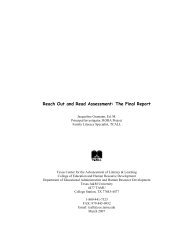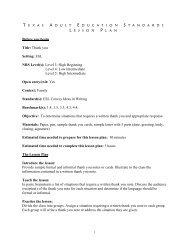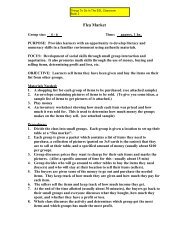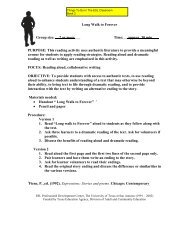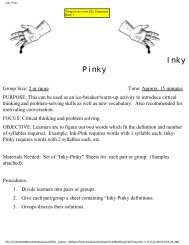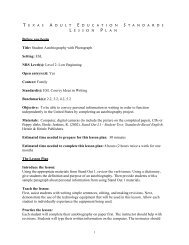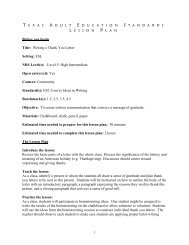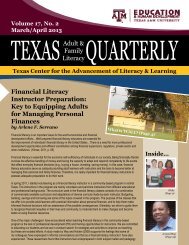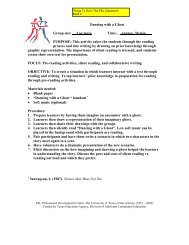Ordeal by Checque
Ordeal by Checque
Ordeal by Checque
Create successful ePaper yourself
Turn your PDF publications into a flip-book with our unique Google optimized e-Paper software.
<strong>Ordeal</strong> <strong>by</strong> Cheque<br />
Group size: 2 or more_ Time:__ approx. 45 min.___<br />
PURPOSE: This is a jigsaw activity that can be used to<br />
promote the use various types of graphic organizers to facilitate reading. As a<br />
result, it can be three activities in one: a Story Sequence, a Jigsaw, and a Character<br />
web. It is also effective in creating group interaction through the delegation of<br />
responsibilities and negotiation of meaning. Can be used as a reading and/or writing<br />
activity.<br />
FOCUS: Creation of a narrative through the use of critical thinking skills such as<br />
inference and prediction, negotiation, and graphic organizers in group interaction.<br />
OBJECTIVE: Create a situation where students use various strategies to sequence<br />
and create a story. Introduce various graphic organizers as a way for learners to<br />
organize and visualize information. In addition, it taps into the learners’ prior<br />
knowledge to interpret a text and to ‘read between the lines”<br />
MATERIALS NEEDED:<br />
• Several copies of <strong>Ordeal</strong> <strong>by</strong> Cheque <strong>by</strong> Wuther Crue 1<br />
• A KWL chart<br />
• A Story Sequence Chart<br />
• Character web<br />
PROCEDURE:<br />
Activity One:<br />
1. Divide the learners into groups of 3-6<br />
2. Have the learners sequence the checks and events in the story<br />
3. The students will then use their own words to complete the Story sequence Chart<br />
Activity Two: Jigsaw:<br />
1. Divide the learners into groups<br />
2. Give each person a K-W-L chart and each group a different third of the story<br />
3. Have one person in the group read the story to the others in their group or they<br />
can take turns reading it to each other.<br />
4. Have them fill in the chart with the information from their aspect of the story<br />
5. Have them regroup into new groups with one student from each of the original<br />
group.<br />
6. As a new group, have them discuss what they know about their sections of the<br />
story and what they want to learn. Have the others tell what they know, and thus<br />
they will be telling the whole story<br />
Activity Three: Character Web<br />
1. Divide the learners into groups<br />
2. Have each group select one of the characters from the story
3. Using the Character Web Graphic organizer have them elaborate on their<br />
character in fuller detail. Examples of of characteristics to be webbed are: what<br />
they do, what they look like. who they interact with, what kind of people are<br />
they,<br />
4. After filling in the graphic organizer, have them write a description of the<br />
character.<br />
Extension Activity:<br />
Although this activity is advanced and requires a certain amount of cultural<br />
background, the gap between what the students know and what they need to know<br />
to participate in this activity is ameliorated <strong>by</strong> the world wide exposure to American<br />
Culture. A useful extension is to have the learners create a culturally appropriate<br />
activity based on <strong>Ordeal</strong> <strong>by</strong> Cheque. An example is included that we call “<strong>Ordeal</strong> <strong>by</strong><br />
Credit Card.” This activity uses the same procedures as <strong>Ordeal</strong> <strong>by</strong> Cheque.<br />
1<br />
Crue, Wurther,(1932). Vanity Fair New York: Conde Nast Publications in Vacca, R & Vacca, J (1999).<br />
Content Area Reading. New York: Longman.




